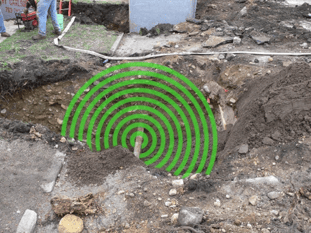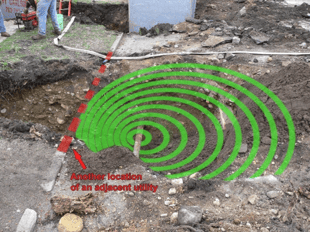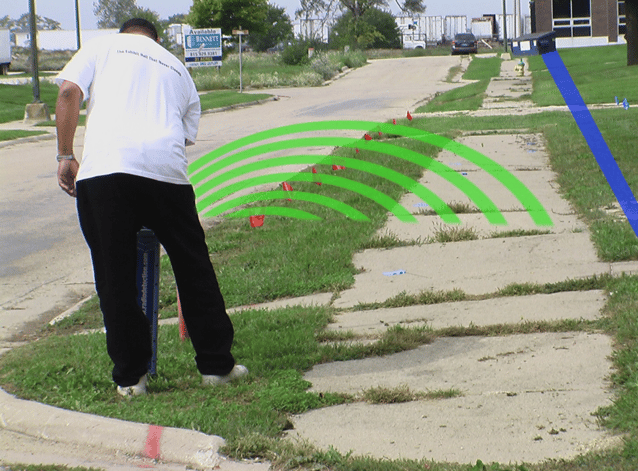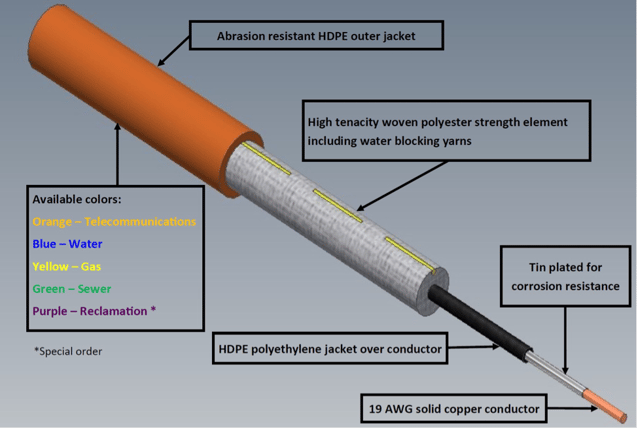Most planning engineers will require a big tracer wire believing a wide gauge conductor will provide a better signal and be more durable than a tracer wire with a narrow gauge. Other planning engineers will require a bigger tracer wire because they believe that a wider gauge conductor will last longer once its buried and provide greater strength during a pull back. In either situation, a bigger tracer wire isn’t better.
A tracer wire is installed along with a plastic pipe or non-metallic cable and it used to carry the locator’s transmitted electromagnetic signal. The tracer wire acts an antenna for the electromagnetic signal. The signal is carried across the outside of the tracer wire and the bigger the wire the more surface area it has which means it takes more the electro-magnetic energy to cover it's surface. More energy means the transmitter must be set to a higher frequency. A higher frequency signal broadcasts a wider electromagnetic field which can lead to inaccurate locates.
Imagine electromagnetic signals have a round shape and are like ripples in water. The signal will seek the path of least resistant back to earth. On most job sites an adjacent utility is nearby which may offer a shorter path back to earth and in these situations the signal will “jump” and the locator will follow and mark the wrong path.


Accurate locating uses the lowest frequency possible. Since narrow gauge wires perform well at low frequency the broadcast signal field is also narrow and reduce the risk of the signal jumping. A wide gauge wire has the potential to broadcast a wider signal field which can lead to mismarked utilities. Inaccurate marking can lead to catastrophic damage and injury.

Long lasting tracer wire starts with a robust insulating jacket that is non-hydroscopic. Most wide gauge tracer wires are not designed for outside use and consequently the conductor has a jacket that is designed that can absorb water and deteriorate and expose the conductor. Once the conductor is exposed any signal that is applied to it will go to ground which prevents an accurate locate. Tracer wire made with HDPE won’t absorb water and will survive in a wet environment. In addition to being non-hydroscopic, the insulating jacket should be tough, abrasion and crush resistant.
A typical wide gauge tracer wire is not inherently strong and have an average break strength of around 200 lbs. This is well under the typical pulling tensions normally experienced during the installation of a plastic pipe through a horizontal directional drill bore. To overcome this problem, it is not uncommon for a contractor to attach multiple tracer wires to the bore head and hope one makes it through to the other side. This is not only costly, there is a very strong possibility that the wire jacket is damaged during the installation and expose the conductor. In addition, a typical wide gauge tracer wire’s jacket will split and expose the conductor if a rock is dropped on it during open trench back filling.
The alternative to wide gauge tracer wire is Trace Safe. Trace Safe’s special construction provide the best performance for locating and durability. Trace Safe has an HDPE insulated 19 AWG tin coated copper conductor that is wrapped in water swellable yarn which is over-jacketed with a thick yet very flexible and light weight HDPE insulation. The four layers of protection combine to provide an overall strength of 1800 lbs. of tensile capability.

Trace Safe will transmit will any frequency over depth and distance but is especially well suited to more accurate low frequency signals. The water blocking yarns serve multiple purposes. In their pure form, if the jacket becomes damaged, the yarn will swell and prevent water from getting to the conductor. They also act as a shock absorber and it takes more than 4,000 pounds of impact before the conductor is compromised. Finally, the yarn serves as a strain relief and absorbs all the tension during directional drilling pull back.
Finally, no tracer wire is effective without reliable splice connections. Stripping the jacket on the wire exposes the conductor to potential water and corrosion. The Trace Safe system utilizes no strip gel-filled connectors that are installed with a simple pair of pliers. The connectors are made of high strength, impact resistant poly-carbonate plastic and when combined with the water-resistant gel provide an additional two layers of protection.
The Trace Safe system is the most complete tracer wire product on the market if you would like to learn more about it please contact us for more information.




